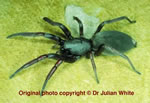|
Lampona cylindrata
|
![Lampona cylindrata ( White-tailed Spider ) [ Original photo copyright © Dr Julian White ]](images/spiders/SPP001921.jpg)
|
|
Suborder: Araneomorphae
|
|
Family: Lamponidae
|
|
Genus: Lampona
|
|
Species: cylindrata
|
Common Names
White-tailed Spider, White tailed Spider
|
Region
Australia
|
Countries
Australia
|
|

|
|
|
|
Taxonomy and Biology
|
|
No information available for Taxonomy and Biology
|
|
|
|
Venom
|
General: Venom Neurotoxins
Not present
|
General: Venom Myotoxins
Not present
|
General: Venom Procoagulants
Not present
|
General: Venom Anticoagulants
Not present
|
General: Venom Haemorrhagins
Not present
|
General: Venom Nephrotoxins
Not present
|
General: Venom Cardiotoxins
Not present
|
General: Venom Necrotoxins
Not present
|
General: Venom Other
Male venom contains small amounts of histamine and noradrenaline
|
|
|
|
Clinical Effects
|
General: Dangerousness
Not dangerous
|
|
General: Rate of Envenoming: All bites cause minimal local effects only
|
|
General: Untreated Lethality Rate: Non-lethal
|
General: Local Effects
Local pain & lump formation
|
General: Local Necrosis
Does not occur, based on current clinical evidence
|
General: General Systemic Effects
Does not occur, based on current clinical evidence
|
General: Myotoxicity
Does not occur, based on current clinical evidence
|
General: Coagulopathy & Haemorrhages
Does not occur, based on current clinical evidence
|
General: Renal Damage
Does not occur, based on current clinical evidence
|
General: Cardiotoxicity
Does not occur, based on current clinical evidence
|
General: Other
Does not occur, based on current clinical evidence
|
|
|
|
First Aid
|
|
Description: First aid for spiderbite (other than noted species, such as Australian funnel web spiders, mouse spiders, widow spiders, recluse spiders, banana spiders).
|
Details
1. After ensuring the patient and onlookers are no longer at risk of further bites by the spider, the bitten person should be reassured and persuaded to lie down and remain still. Some will be terrified, fearing sudden death and, in this mood, they may behave irrationally or even hysterically. The basis for reassurance is the fact that many bites do not result in envenoming, death is a very rare outcome, and the effectiveness of modern medical treatment.
2. The bite wound should not be tampered with in any way.
3. Some victims find the application of a local cold pack may relieve local pain.
4. Do not apply a local bandage, tourniquet, or cut or suck or incise the wound or apply electric shock. Application of local heat has not proved beneficial.
5. If there is any impairment of vital functions, such as problems with respiration, airway, circulation, heart function, these must be supported as a priority. In particular, for bites causing flaccid paralysis, including respiratory paralysis, both airway and respiration may be impaired, requiring urgent and prolonged treatment, which may include the mouth to mask (mouth to mouth) technique of expired air transfer. Seek urgent medical attention.
6. If the offending spider has been killed or caught it should be brought with the patient for identification.
7. Avoid peroral intake, other than clear fluids, in the first 6 hours, absolutely no alcohol. No sedatives outside hospital. If there will be considerable delay before reaching medical aid, measured in several hours to days, then give clear fluids by mouth to prevent dehydration.
8. Most traditional, and many of the more recently fashionable, first aid measures are useless and potentially dangerous. These include local cauterization, incision, excision, amputation, suction by mouth, vacuum pump or syringe, combined incision and suction ("venom-ex" apparatus), injection or instillation of compounds such as potassium permanganate, phenol (carbolic soap) and trypsin, application of electric shocks or ice (cryotherapy), use of traditional herbal, folk and other remedies including the ingestion of emetic plant products and parts of the spider, multiple incisions, tattooing and so on.
9. If the spider is known to be harmless, it may not be necessary to seek medical aid, but if in any doubt, either seek urgent advice from the regional poisons information service or regional hospital, or transport the patient to a hospital.
|
|
|
|
Treatment
|
Treatment Summary
Bites by white tailed spiders cause only mild local effects, not requiring medical treatment, unless secondary infection develops (rare).
|
Key Diagnostic Features
Immediate local pain, then lump formation. No tissue injury or necrosis.
|
General Approach to Management
Most cases will be minor & not require admission.
|
Antivenom Therapy
No antivenom available
|
|
|
|
Images
|

|
|
|
|
|
|
|
Lampona cylindrata ( White-tailed Spider ) [ Original photo copyright © Dr Julian White ]
|
|
|
|
|
|
|
|
|



